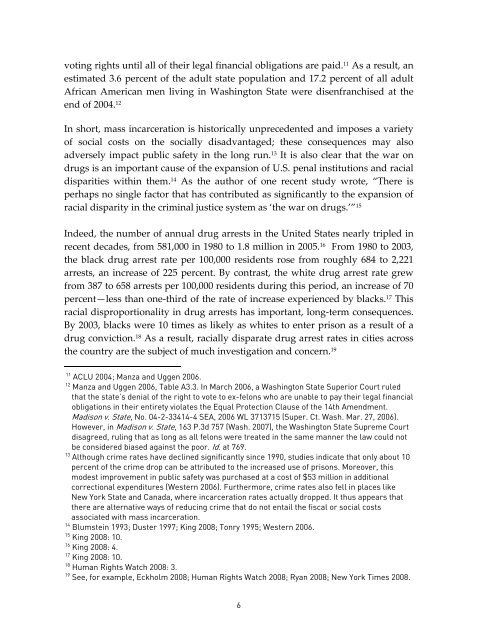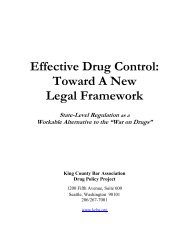RACE AND THE ENFORCEMENT OF DRUG DELIVERY LAWS IN ...
RACE AND THE ENFORCEMENT OF DRUG DELIVERY LAWS IN ...
RACE AND THE ENFORCEMENT OF DRUG DELIVERY LAWS IN ...
Create successful ePaper yourself
Turn your PDF publications into a flip-book with our unique Google optimized e-Paper software.
voting rights until all of their legal financial obligations are paid. 11 As a result, an<br />
estimated 3.6 percent of the adult state population and 17.2 percent of all adult<br />
African American men living in Washington State were disenfranchised at the<br />
end of 2004. 12<br />
In short, mass incarceration is historically unprecedented and imposes a variety<br />
of social costs on the socially disadvantaged; these consequences may also<br />
adversely impact public safety in the long run. 13 It is also clear that the war on<br />
drugs is an important cause of the expansion of U.S. penal institutions and racial<br />
disparities within them. 14 As the author of one recent study wrote, “There is<br />
perhaps no single factor that has contributed as significantly to the expansion of<br />
racial disparity in the criminal justice system as ‘the war on drugs.’” 15<br />
Indeed, the number of annual drug arrests in the United States nearly tripled in<br />
recent decades, from 581,000 in 1980 to 1.8 million in 2005. 16 From 1980 to 2003,<br />
the black drug arrest rate per 100,000 residents rose from roughly 684 to 2,221<br />
arrests, an increase of 225 percent. By contrast, the white drug arrest rate grew<br />
from 387 to 658 arrests per 100,000 residents during this period, an increase of 70<br />
percent—less than one-third of the rate of increase experienced by blacks. 17 This<br />
racial disproportionality in drug arrests has important, long-term consequences.<br />
By 2003, blacks were 10 times as likely as whites to enter prison as a result of a<br />
drug conviction. 18 As a result, racially disparate drug arrest rates in cities across<br />
the country are the subject of much investigation and concern. 19<br />
11 ACLU 2004; Manza and Uggen 2006.<br />
12 Manza and Uggen 2006, Table A3.3. In March 2006, a Washington State Superior Court ruled<br />
that the state’s denial of the right to vote to ex-felons who are unable to pay their legal financial<br />
obligations in their entirety violates the Equal Protection Clause of the 14th Amendment.<br />
Madison v. State, No. 04-2-33414-4 SEA, 2006 WL 3713715 (Super. Ct. Wash. Mar. 27, 2006).<br />
However, in Madison v. State, 163 P.3d 757 (Wash. 2007), the Washington State Supreme Court<br />
disagreed, ruling that as long as all felons were treated in the same manner the law could not<br />
be considered biased against the poor. Id. at 769.<br />
13 Although crime rates have declined significantly since 1990, studies indicate that only about 10<br />
percent of the crime drop can be attributed to the increased use of prisons. Moreover, this<br />
modest improvement in public safety was purchased at a cost of $53 million in additional<br />
correctional expenditures (Western 2006). Furthermore, crime rates also fell in places like<br />
New York State and Canada, where incarceration rates actually dropped. It thus appears that<br />
there are alternative ways of reducing crime that do not entail the fiscal or social costs<br />
associated with mass incarceration.<br />
14<br />
Blumstein 1993; Duster 1997; King 2008; Tonry 1995; Western 2006.<br />
15<br />
King 2008: 10.<br />
16 King 2008: 4.<br />
17<br />
King 2008: 10.<br />
18 Human Rights Watch 2008: 3.<br />
19<br />
See, for example, Eckholm 2008; Human Rights Watch 2008; Ryan 2008; New York Times 2008.<br />
6

















